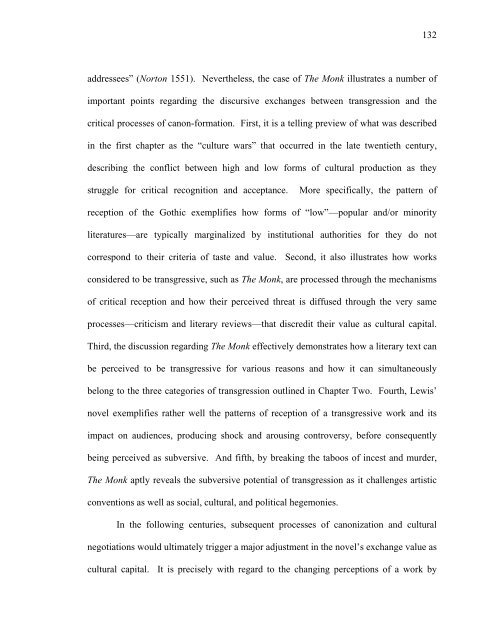Untitled - Sexey's School Moodle
Untitled - Sexey's School Moodle
Untitled - Sexey's School Moodle
Create successful ePaper yourself
Turn your PDF publications into a flip-book with our unique Google optimized e-Paper software.
addressees” (Norton 1551). Nevertheless, the case of The Monk illustrates a number of<br />
important points regarding the discursive exchanges between transgression and the<br />
critical processes of canon-formation. First, it is a telling preview of what was described<br />
in the first chapter as the “culture wars” that occurred in the late twentieth century,<br />
describing the conflict between high and low forms of cultural production as they<br />
struggle for critical recognition and acceptance. More specifically, the pattern of<br />
reception of the Gothic exemplifies how forms of “low”—popular and/or minority<br />
literatures—are typically marginalized by institutional authorities for they do not<br />
correspond to their criteria of taste and value. Second, it also illustrates how works<br />
considered to be transgressive, such as The Monk, are processed through the mechanisms<br />
of critical reception and how their perceived threat is diffused through the very same<br />
processes—criticism and literary reviews—that discredit their value as cultural capital.<br />
Third, the discussion regarding The Monk effectively demonstrates how a literary text can<br />
be perceived to be transgressive for various reasons and how it can simultaneously<br />
belong to the three categories of transgression outlined in Chapter Two. Fourth, Lewis’<br />
novel exemplifies rather well the patterns of reception of a transgressive work and its<br />
impact on audiences, producing shock and arousing controversy, before consequently<br />
being perceived as subversive. And fifth, by breaking the taboos of incest and murder,<br />
The Monk aptly reveals the subversive potential of transgression as it challenges artistic<br />
conventions as well as social, cultural, and political hegemonies.<br />
132<br />
In the following centuries, subsequent processes of canonization and cultural<br />
negotiations would ultimately trigger a major adjustment in the novel’s exchange value as<br />
cultural capital. It is precisely with regard to the changing perceptions of a work by



